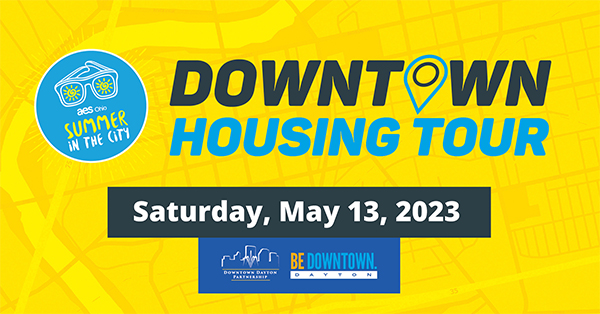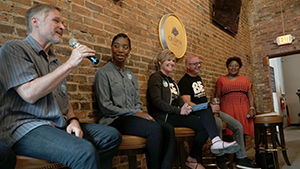With hundreds of new housing units currently under construction, there’s never been a better time to think about living in downtown Dayton!

Find out why downtown is the hottest, most in-demand real estate market in the region during our free Downtown Housing Tour on Saturday, May 13, from 1 to 5 p.m., sponsored by AES Ohio, Centerpoint Energy, Dayton.com, Key Ads, Glasshouse Realty Group, and the Greater Dayton RTA.
DOWNLOAD THE EVENT MAP & BROCHURE
You’re invited to this showcase of downtown housing options in a variety of styles and locations. Take a sneak peek at some upcoming development projects and hear from downtown residents about why they choose to live downtown.
This is an open-house style event – there is no hard start or stop time! Start your tour at any of the tour sites, or at one of the information stations found on the map.
Metered parking spaces are free on the weekends and The Greater Dayton RTA has generously provided complimentary shuttles for quick transport between various tour locations. Guests are also encouraged to walk or use the Link Bike Share system to travel between destinations.
Experience the fun and convenience of downtown living, with restaurants, brewpubs, shops, performing arts, galleries and more just steps away.
Hop on and off the free tour shuttles, or see the tour on foot or bike.
 DOWNTOWN RESIDENTS PANEL DISCUSSION
DOWNTOWN RESIDENTS PANEL DISCUSSION
12:00 TO 1:00 P.M. ON MAY 13
AT GLASSHOUSE REALTY GROUP, 201 E. SIXTH ST.
Sponsored by Glasshouse Realty Group
What is it really like to live downtown? Find out from some of the people who live here! Join us for an informal panel discussion with downtown residents from a variety of age groups and backgrounds. Learn what they love most (or least) about being downtown and ask them your burning questions.
This event is free, but pre-registration is required for the panel discussion. Walk-ins accepted as space allows.
REGISTER FOR THE DOWNTOWN RESIDENTS PANEL DISCUSSION
GETTING AROUND
FREE SHUTTLES – Free housing tour shuttles, courtesy of the Greater Dayton RTA, will run during the event, making stops near each housing option on the tour. Hop on and off at any of the shuttle stops to check out as many or as few of the housing options as you like. A shuttle should be at each stop every 10-15 minutes.
WALKING – Walking is another great way to get around – most of the housing options on the tour are no more than a five minute walk apart.
BIKING – Or, try downtown’s Link bike share! Rent a green bike from one of the many Link stations throughout downtown and ride to another station near your next destination.
PARKING
Downtown has more than 13,000 parking spaces. You can find a list and map of garages and lots here, and street parking metered spots are free on weekends!
MORE DOWNTOWN HOUSING INFO
Our tour highlights just a few of the many apartments, condominiums, and traditional homes in downtown Dayton and its surrounding neighborhoods. For more info on downtown living, visit our directory of housing options and other resources.

 Noah agreed and went on to describe how Stivers’ school pride impressed him. “The school had a gift shop; that was pretty different,” he said. One hurdle down: Noah auditioned and was accepted to Stivers’ choral program. He began his freshman year in August.
Noah agreed and went on to describe how Stivers’ school pride impressed him. “The school had a gift shop; that was pretty different,” he said. One hurdle down: Noah auditioned and was accepted to Stivers’ choral program. He began his freshman year in August.


 Even though their new apartment home is physically smaller than their suburban digs, they said they don’t feel cramped or that they lack space. “There are so many places to visit and they’re practically in our back yard,” Kevin said. Giving one particular weekend as an example, the couple recounted attending a
Even though their new apartment home is physically smaller than their suburban digs, they said they don’t feel cramped or that they lack space. “There are so many places to visit and they’re practically in our back yard,” Kevin said. Giving one particular weekend as an example, the couple recounted attending a  From the Rehfuses’ home, perched on the banks of the Great Miami River, they will have front-row seats to watch more active lifestyle amenities come online. Construction has started on the new
From the Rehfuses’ home, perched on the banks of the Great Miami River, they will have front-row seats to watch more active lifestyle amenities come online. Construction has started on the new  The abundance of action wasn’t the only surprise
The abundance of action wasn’t the only surprise 





